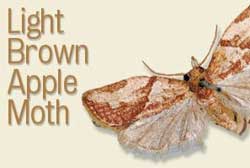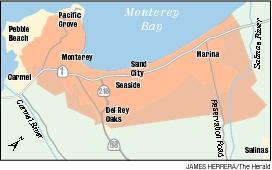SACRAMENTO, August 14, 2007, Beginning the evening of September 5, a team of three airplanes will begin releasing a pheromone designed to confuse male light brown apple moths (LBAM) and keep them from locating a mate. The pheromones are scheduled to be applied over approximately 60 square miles including the communities of Marina, Seaside, Sand City, Del Rey Oaks, Monterey and Pacific Grove. The application will occur over two to three nights, with a second application scheduled to occur in the same area in October (see map at http://www.cdfa.ca.gov/phpps/pdep/lbam_main.htm).
While conventional insecticides are designed to kill insects, pheromones are designed to distract or confuse them so that they cannot breed. In nature, the pheromone is released by the female moth to attract a mate. The ?scent? is undetectable to humans and is highly specific to the light brown apple moth, so it does not affect other kinds of insects or animals. The aerial releases, which will resemble a light mist, are intended to surround the local moth population with pheromone so that the male moths can?t locate the female moths. The moth population will decline and collapse as the rate of breeding slows and eventually subsides. The pheromone remains effective for about a month. This insect is a threat not only to our agricultural crops but also to our natural habitat, parks and landscaping, redwoods, oaks and other prized elements of our environment, said CDFA Secretary A.G. Kawamura. It was important to identify an eradication alternative that took all of these conditions and constraints into account, and I believe we have succeeded in finding the most appropriate approach. Pheromone release is among the most advanced and environmentally sensitive eradication tools ever used in California. Agricultural officials from the federal, state and county levels involved in the Cooperative Light Brown Apple Moth Eradication Project will provide two informational Open House sessions so that area residents can learn more about the project and discuss any questions or concerns one-on-one with experts in areas such as human health, environment and habitat, insect biology, eradication efforts, and quarantine restrictions. Residents in the treatment area will receive notices by mail detailing both the treatment schedule and the open house sessions.
Monday, August 20, 2007, 6-9 p.m. Tuesday, August 21, 2007, 6-9 p.m. Monterey Peninsula Unified School District Boardroom When applications begin the night of September 5, the planes will release an odorless, colorless pheromone material called Checkmate OLR-F which has been reviewed and approved by the EPA and the California Department of Pesticide Regulation. The product has been registered and in use for over a decade with no reports of any health or environmental effects. The contractor for the aerial applications is Dynamic Aviation, the same company that CDFA has contracted with for several years to release sterile Mediterranean fruit flies to prevent infestations in the Los Angeles basin. The company will fly three King Air twin-turbine aircraft flying at an altitude of approximately 500-800 feet to release the pheromone, using Salinas Municipal Airport as their base of operations. Global Positioning Satellite (GPS) systems will guide the pilots on preset grids. Over the past few months, these communities have been part of a regional quarantine that has helped keep the infestation from spreading to other areas of the state. Now that the cooperative team of federal, state and local agricultural officials has deployed an array of insect traps throughout the state and determined that the infestation is largely confined to the Central Coast and East Bay areas, leading scientists have prescribed these pheromone treatments as the next step toward eradication. The Monterey/Seaside/Marina portion of the infested areas was chosen for the first round of pheromone applications because of its proximity to crops susceptible to the LBAM infestation. Pheromone releases in other infested areas will be planned as the program progresses. The light brown apple moth is of particular concern because it can damage a wide range of crops and other plants including the Central Coasts prized cypress as well as redwoods, oaks and many other varieties commonly found in our urban and suburban landscaping, public parks, and natural environment. The list of agricultural crops that could be damaged by this pest includes grapes, citrus, stone fruits (peaches, plums, nectarines, cherries, apricots) and many others. The complete host list contains well over 250 plant species. The pest damages plants and crops by feeding on leaves, new shoots and fruit -30- The California Department of Food and Agriculture protects and promotes California's $31.8 billion agricultural industry. California's farmers and ranchers produce a safe, secure supply of food, fiber and shelter; marketed fairly for all Californians; and produced with responsible environmental stewardship.
California Department of Food and Agriculture Office of Public Affairs Nancy Lungren, Deputy Secretary 1220 N St., Ste. 214, Sacramento, CA 95814 916-654-0462, www.cdfa.ca.gov |


